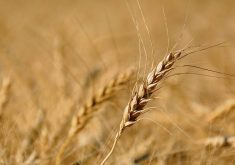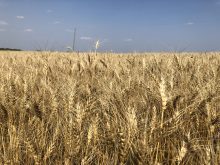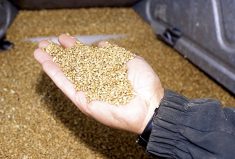When it comes to marketing, it’s important to know the product. And this is never more important than when selling crops.
“Some crops are more complex than others to grade,” said Neil Blue, market specialist with Alberta Agriculture and Rural Development in Vermilion.
“For example, canola is typically graded based on appearance, smell, moisture content, inseparable weed seeds and foreign matter as well as percentage of seeds with distinctly green colour or heat damage when crushed. Some buyers may also test for oil content in canola seed.
Read Also

New crop insurer policy enables easier startup for faba beans
Agriculture Financial Services Corporation updated its normals for faba beans, which may open the door for more Canadian producers to feel comfortable growing the pulse crop in the future.
“Wheat grades include type, appearance factors, inseparable seeds, ergot, and foreign material, as well as protein content and sometimes falling number.”
Obtaining a representative sample of the product is an essential part of marketing, said Blue. The goal is to have a sample that has the same characteristics as the large volume of product that it represents.
“Taking samples as harvested grain is placed into storage is a practical way to obtain a representative sample for each bin,” he said.
- More from the Alberta Farmer Express: Get the AARD fact sheets on grain storage
“Commercial samplers or homemade samplers have a similar design, such as a small can on the end of a stick. As the grain is flowing, pass the cup along the stream of grain at regular intervals and dump it into a larger container. Try to take a consistent number of cup samples relative to the larger grain volume from each load.
“After a bin is full, mix the grain well in the sample pail and keep part of that mixed sample as the representative sample for that bin. Make sure that you keep a large enough sample to use in distributing the sample to different graders. Keep the sample in a sealed container labelled to identify the source bin. This container should keep out rodents and insects and preserve representative moisture content to maintain sample integrity.”
Producers should be aware of the Harvest Sample Program that the Canada Grain Commission offers, said Blue.
“This program gives producers a free unofficial grade on samples from the current year’s crop. Producers can submit samples of newly harvested crop prior to November. Upon registering with the commission by phone, email or via its website, it will send participating producers a personalized kit, including postage-paid envelopes for the samples.
“The toll-free registration phone number is 1-800-853-6705, and the commission is welcoming new registrants.”
Up to eight samples per producer are eligible for this free service, and the program can be used for cereal grains, pulses, canola, flaxseed, mustard seed and soybeans.
Results can be sent by email or obtained by phone or on the commission’s website.
Alternatively, the Canadian Grain Commission’s submitted sample service is available to producers year round for a fee. Under this program, producers receive a certificate that shows:
- Grade (including main degrading reason if relevant);
- Dockage;
- Moisture (if sample is received in a moisture-proof container);
- Protein content for wheat samples by request;
- Oil, protein and chlorophyll content for canola;
- Oil, protein content and iodine value for flaxseed;
- Oil and protein for mustard seed and soybeans.
“Records of the stored crop samples should be maintained, together with comments and reminders applicable to each bin,” said Blue. “As grade assessments are gathered from various buyers, note those assigned grades in your records. You may find that not all buyers give the same grade to a sample, and that information becomes a factor in your marketing decision.
“If you use the Canada Grain Commission grading service, consider its assessment of grade to be the base grade for that crop sample. Once you have gathered grade information, you can then work on determining the best outlet for that crop from a grade point of view, and recognizing that the net farm gate price and payment security will likely be the major factors in your final marketing decision.”















